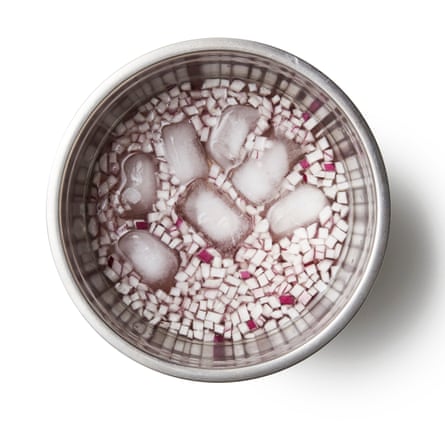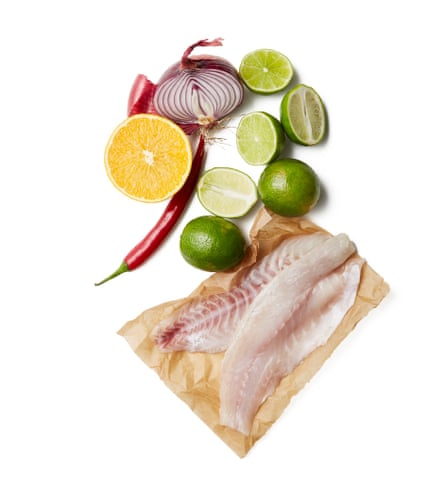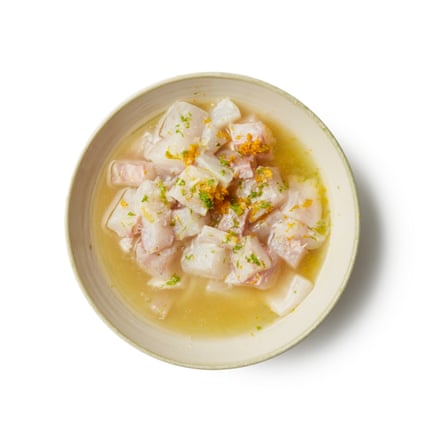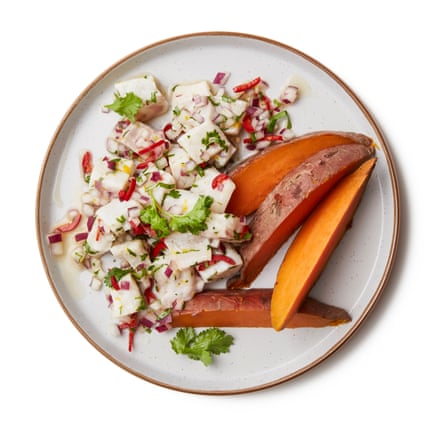The pleasures of Latin American cuisine are still far too little known in the UK. Ceviche, which is popular from Panama to Peru, where it’s the official national dish, is a good place to start for fish-lovers, because it’s quick and easy to make, yet far more than the sum of its few parts. An ideal – and very healthy – starter or light lunch.
Prep 10 min
Marinate 10 min
Serves 2
½ red onion, trimmed and peeled
250g sustainably sourced sea bass or sea bream fillets, skinned and boned (see step 2)
½ tsp fine salt, plus extra to season
Juice of 4 limes
Juice of ½ orange
1 red chilli, mild or hot as you prefer, or 1 tsp aji amarillo paste (optional)
1 small bunch coriander, roughly chopped
1 Chop and soak the onion

Finely chop the onion (or use a shallot instead or, at a pinch, a yellow or spring onion, though those last two lack the sweetness that makes red onion the best choice). Put the onion in a bowl of iced water, and leave to soak for five minutes while you prepare the fish – the onion will soften in flavour, so it won’t overpower the delicate seafood later.
2 A word on the fish
The fish in ceviche is not cooked, but marinated in acidic ingredients that denature the proteins in much the same way that heat would. This gives it a dryer, firmer texture, so it’s important to choose a species that’s robust enough to stand up to such treatment. I find a firm-fleshed white fish such as sea bass or bream works best.

3 Alternative seafood
That said, even in ceviche’s home region, no single species is particularly favoured – inland, freshwater fish such as trout or piranha might be used, while at the coast, tilapia, octopus or shellfish such as clams, prawns and even barnacles are common – so play around as you fancy, but remember to adjust the marinating time to suit both the seafood you use and your own tastes.
4 Dice the fish evenly
Cut whatever fish you’re using into roughly 1½-2cm chunks – if they’re too wildly different in size, the fish will “cook” at different rates. You could slice it very thinly for a more elegant, restaurant-style presentation, but I find this eliminates the pleasing contrast between the soft middle and the cooked exterior, so I prefer to dice it.

5 Salt the fish and prep the citrus
Put the fish in a medium bowl with half a teaspoon of salt, then rub it in gently – I find it easiest to do this with my hands. Leave it to sit for a minute while you prepare the citrus. Juice the limes and orange (or use limes alone, or seville oranges, when in season) directly into the fish bowl, and add a little of their grated zest, if you like, though don’t go overboard.
6 Add the chilli
Finely shred the chilli, if using, removing the seeds and pith if you’re averse to heat, then stir into the fish, or dollop the paste on top and toss to combine. (Aji amarillo is a hot yet fruity chilli that’s hard to find in the UK, though you can buy it powdered or as a ready-mixed paste online.)

7 Macerate for 10 minutes
Leave the fish to sit for about 10 minutes – traditionally, the marination time was several hours, to allow the acid to penetrate the fish properly, “cooking” it all the way through, but in the past few decades, the trend has been for a shorter soak, so the centre of the fish remains raw. Experiment to see what suits your taste.
8 Finishing touches

Meanwhile, roughly chop the coriander (or parsley, if you prefer). Once the ceviche is sufficiently marinated to your liking, check the seasoning, and adjust as necessary – a little more salt, perhaps, or orange juice for sweetness. Stir in the coriander, then divide the fish and its marinade between two bowls and serve immediately.
9 Serving suggestions

It’s delicious on its own, but you can bulk ceviche out by serving it with a sprinkling of giant corn kernels, some plantain chips (make your own or buy one of the Caribbean brands) or wedges of steamed, boiled or baked sweet potato. It’s also pretty good on tacos or with unseasoned tortilla chips, Central American-style.
-
The Guardian aims to publish recipes for sustainable fish. Check ratings in your region: UK; Australia; US.
"food recipes" - Google News
May 17, 2023 at 06:00PM
https://ift.tt/WgXcOms
How to make ceviche – recipe - The Guardian
"food recipes" - Google News
https://ift.tt/FA04GYJ
https://ift.tt/gXLV51i

No comments:
Post a Comment